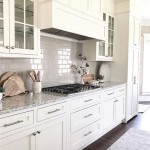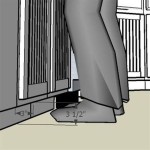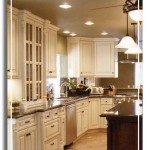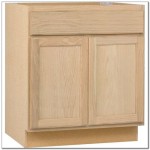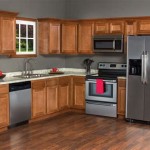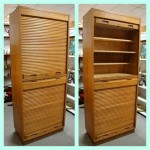How To Clean Plastic Coated Kitchen Cabinets
Plastic coated kitchen cabinets offer a durable and relatively inexpensive option for homeowners. These cabinets, often composed of a particleboard or MDF core wrapped in a layer of melamine, vinyl, or laminate, provide a smooth, easy-to-clean surface. However, while the plastic coating is resilient, it's not invincible. Improper cleaning techniques and harsh chemicals can damage the surface, leading to discoloration, scratches, or even peeling. Therefore, understanding the appropriate methods and materials for cleaning these cabinets is crucial for maintaining their appearance and longevity.
Effective cleaning involves a multi-faceted approach encompassing regular maintenance, stain removal, and occasional deep cleaning. Consistent upkeep minimizes the buildup of grease, grime, and food splatters, preventing them from becoming stubborn and difficult to remove. Selecting the right cleaning solutions and tools is equally important, as abrasive materials and aggressive chemicals can irreparably harm the plastic coating. This article provides a comprehensive guide to effectively and safely cleaning plastic coated kitchen cabinets, ensuring they remain in excellent condition for years to come.
Regular Cleaning: Maintaining a Pristine Surface
The cornerstone of cabinet care is consistent regular cleaning. This preventive measure significantly reduces the likelihood of persistent stains and the need for harsh cleaning agents. A simple routine, performed weekly or bi-weekly, can substantially extend the life and improve appearance of plastic coated kitchen cabinets.
Microfiber cloths are ideal for regular cleaning due to their non-abrasive nature and ability to effectively lift dirt and grease. A soft sponge can also be used, but avoid scouring pads or abrasive brushes, as these can scratch the plastic coating. For a general cleaning solution, mild dish soap diluted in warm water is highly effective. Avoid using excessive amounts of soap, as this can leave a residue that attracts more dirt. The ratio of soap to water should be minimal, typically a teaspoon of soap per gallon of water.
Dampen the microfiber cloth or sponge in the soapy water, ensuring it is not overly saturated. Wring out any excess water to prevent it from dripping onto the cabinets and potentially seeping into any seams or edges. Gently wipe down the cabinet surfaces, paying attention to areas that are prone to grease buildup, such as around the stove and oven. Rinse the cloth or sponge frequently in clean water to remove accumulated dirt and grime. After wiping the cabinets with the soapy solution, use a clean, dry microfiber cloth to thoroughly dry the surfaces. This step is crucial to prevent water spots and streaks from forming. Regular dusting is also recommended. Use a dry microfiber cloth to remove dust and debris from the cabinets before washing them.
Pay special attention to cabinet hardware, such as knobs and pulls. These areas often accumulate fingerprints and grime. Use a soft brush, such as an old toothbrush, to gently clean around the hardware. After cleaning, dry the hardware with a clean cloth to prevent corrosion.
Tackling Stubborn Stains: Effective Stain Removal Techniques
Despite regular cleaning, stubborn stains may occasionally appear on plastic coated kitchen cabinets. These stains can be caused by food spills, grease splatters, or other substances that are not immediately removed. Prompt and appropriate stain removal is essential to prevent permanent discoloration.
Before resorting to harsh chemicals, consider using natural cleaning agents. Baking soda is a mild abrasive that can effectively remove many types of stains. Create a paste by mixing baking soda with a small amount of water. Apply the paste to the stain and gently rub it with a soft cloth or sponge. Rinse the area thoroughly with clean water and dry with a clean cloth. Vinegar, diluted with water, is another effective cleaning agent for removing grease and grime. Mix equal parts vinegar and water in a spray bottle. Spray the solution onto the stain and let it sit for a few minutes. Wipe the area clean with a soft cloth and dry with a clean cloth. For greasy stains, a paste made from cornstarch and water can be helpful. Apply the paste to the stain, let it dry, and then brush it off with a soft cloth.
When natural cleaning agents are insufficient, specialized cleaning products may be necessary. Choose cleaning products that are specifically designed for plastic or laminate surfaces. Avoid using abrasive cleaners, scouring pads, or bleach, as these can damage the plastic coating. Always test the cleaning product on an inconspicuous area of the cabinet before applying it to the entire surface. This ensures that the product does not cause discoloration or damage. Follow the manufacturer's instructions carefully when using any cleaning product. Apply the cleaning product to a soft cloth or sponge and gently wipe the stain. Rinse the area thoroughly with clean water and dry with a clean cloth. Repeat the process if necessary. For particularly stubborn stains, consider using a magic eraser. These melamine foam sponges can effectively remove many types of stains, but they can also be mildly abrasive. Use them sparingly and test them on an inconspicuous area first.
After removing a stain, it's crucial to thoroughly clean and dry the affected area. This prevents the stain from reappearing and ensures that the cleaning product does not leave a residue. Use a clean, damp microfiber cloth to wipe the area and then dry it with a clean, dry microfiber cloth. Inspect the area carefully to ensure that the stain is completely removed. If the stain persists, repeat the cleaning process or try a different cleaning agent.
Protecting Your Investment: Preventing Damage and Maintaining Finish
Beyond regular cleaning and stain removal, proactive measures are essential to preserving the finish and preventing damage to plastic coated kitchen cabinets. These preventative steps can significantly extend the lifespan and maintain the aesthetic appeal of the cabinets.
Heat and moisture are among the most significant threats to plastic coated cabinets. Avoid placing hot pots or pans directly on the cabinet surfaces. Always use trivets or heat-resistant mats to protect the plastic coating from heat damage. Similarly, avoid exposing the cabinets to excessive moisture. Wipe up spills immediately and ensure that the area around the sink is kept dry. Excessive moisture can cause the plastic coating to peel or warp. Steam from dishwashers can be particularly damaging. Ensure the dishwasher is properly vented and avoid opening the dishwasher immediately after a cycle. This allows the steam to dissipate before it can damage the cabinets.
Sunlight can also cause fading and discoloration of plastic coated cabinets. Consider using window coverings, such as blinds or curtains, to protect the cabinets from direct sunlight. Regularly inspect cabinets for signs of damage, such as scratches, chips, or peeling. Addressing these issues promptly can prevent them from worsening. Minor scratches can often be repaired with touch-up paint or laminate repair kits. For more significant damage, consult a professional.
Choose cleaning products wisely. Avoid using abrasive cleaners, scouring pads, or harsh chemicals, as these can damage the plastic coating. Opt for mild, non-abrasive cleaning solutions that are specifically designed for plastic or laminate surfaces. The use of furniture polish is generally not recommended for plastic coated cabinets. The polish can leave a residue that attracts dirt and grime. If polish is desired, test it on an inconspicuous area first to ensure that it does not damage the surface.
When installing new hardware or making repairs, exercise caution to avoid scratching or damaging the cabinets. Use protective mats or cloths to cover the cabinets during these activities. Finally, consider applying a protective sealant to the cabinets. This can help to protect the plastic coating from scratches, stains, and moisture. Choose a sealant that is specifically designed for plastic or laminate surfaces and follow the manufacturer's instructions carefully. Applying a protective sealant every few years can significantly extend the lifespan and maintain the appearance of plastic coated kitchen cabinets.
By adhering to a consistent cleaning schedule, employing appropriate cleaning techniques, and implementing preventative measures, homeowners can ensure that their plastic coated kitchen cabinets remain in excellent condition for years to come. The longevity and appearance of these cabinets depend on diligent care and the avoidance of harsh chemicals and abrasive cleaning methods. Consistent and gentle maintenance is key to maximizing the lifespan and aesthetic appeal of this kitchen feature.

How To Clean White Kitchen Cabinets 3 Best Ways Avoid Abbotts At Home

How To Clean White Kitchen Cabinets 3 Best Ways Avoid Abbotts At Home

Tips To Clean Laminate Surfaces And Maintenance Ideas

What Is Making My Kitchen Cabinet Paint L The Picky Painters Berea Oh

How To Paint Laminate Kitchen Cabinets Perfect Finish Tips

How To Clean Kitchen Cabinets 9 Basics Bob Vila

How To Clean Kitchen Cabinets Pink Solution Corp

How To Clean Cabinets Before Painting Ultimate Guide With Pro Tips Grace In My Space

How To Paint Laminate Cabinets Everything You Need Know

How To Paint Kitchen Cabinets Without Sanding Or Priming
Related Posts

